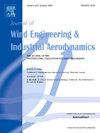柔性双气缸流激振动及被动吸喷控制抑制实验研究
IF 4.9
2区 工程技术
Q1 ENGINEERING, CIVIL
Journal of Wind Engineering and Industrial Aerodynamics
Pub Date : 2025-07-26
DOI:10.1016/j.jweia.2025.106186
引用次数: 0
摘要
实验研究了L/D = 3,4,5和T/D = 0,1,2组合的9种交错排列柔性双圆柱间的干涉振动。分析了主要振动模式、相位差和频率特性,并验证了被动吸力喷射控制方法。在高风速下,除了高阶涡激振动(VIV)外,还发现了三种大振幅振动类型:尾迹诱导振动(WIV)、尾迹诱导颤振(WIF)和LSTR(层流分离与湍流再附着)流型诱导水平振动(LHV),后者是柔性实验中首次观察到的。在LHV过程中,下游气缸的水平运动以一阶模态为主,而垂直运动以高阶模态为主,且气缸间的相干性较差。在WIF和WIV中都观察到频率锁定现象,这被证明是WIF发生的必要条件。在近间距时,圆柱主要表现为垂直的近似反相涡激振动,这是由剪切层相互作用引起的。最优控制方案采用3/4跨长的管道装置,有效抑制了三种大振幅振动类型,并减轻了各种阶次的涡激振动(串列反相涡激振动除外)。本文章由计算机程序翻译,如有差异,请以英文原文为准。
Experimental study on flow-induced vibration of flexible twin cylinders and its suppression using passive-suction-jet control
This study experimentally investigates interference-induced vibrations between flexible twin cylinders in nine staggered arrangements with L/D = 3, 4, 5 and T/D = 0, 1, 2 combinations. Dominant vibration modes, phase differences, and frequency characteristics were analyzed, along with the validation of a passive-suction-jet control method. At high wind speeds, besides higher-order vortex-induced vibration (VIV), three types of large-amplitude vibration were identified: wake-induced vibration (WIV), wake-induced flutter (WIF), and LSTR (laminar separation and turbulent reattachment) flow pattern-induced horizontal vibration (LHV)—the latter being observed for the first time in flexible experiments. During LHV, the downstream cylinder exhibited first-mode dominated horizontal motion while its vertical motion was characterized by higher-order modes, with poor coherence between the cylinders. The frequency-locking phenomenon was observed in both WIF and WIV, and proved essential for WIF occurrence. At close spacing, the cylinders primarily displayed vertical approximately anti-phase VIV, which was caused by shear layer interactions. The optimal control scheme, which employs pipe installations of 3/4 span length, effectively suppresses all three large-amplitude vibration types and mitigates various orders of VIV (except for anti-phase VIV in tandem arrangements).
求助全文
通过发布文献求助,成功后即可免费获取论文全文。
去求助
来源期刊
CiteScore
8.90
自引率
22.90%
发文量
306
审稿时长
4.4 months
期刊介绍:
The objective of the journal is to provide a means for the publication and interchange of information, on an international basis, on all those aspects of wind engineering that are included in the activities of the International Association for Wind Engineering http://www.iawe.org/. These are: social and economic impact of wind effects; wind characteristics and structure, local wind environments, wind loads and structural response, diffusion, pollutant dispersion and matter transport, wind effects on building heat loss and ventilation, wind effects on transport systems, aerodynamic aspects of wind energy generation, and codification of wind effects.
Papers on these subjects describing full-scale measurements, wind-tunnel simulation studies, computational or theoretical methods are published, as well as papers dealing with the development of techniques and apparatus for wind engineering experiments.

 求助内容:
求助内容: 应助结果提醒方式:
应助结果提醒方式:


